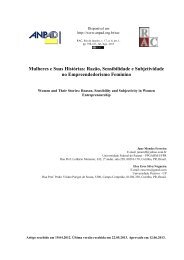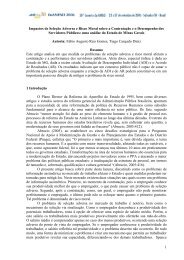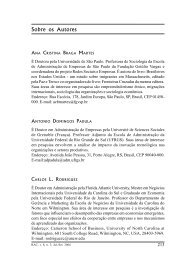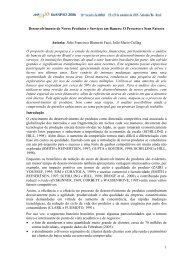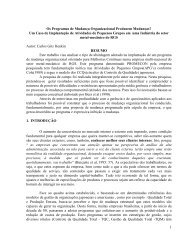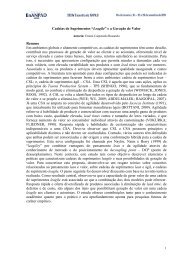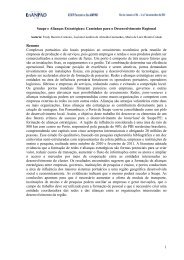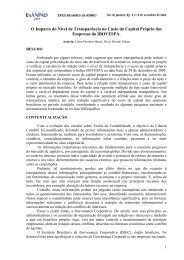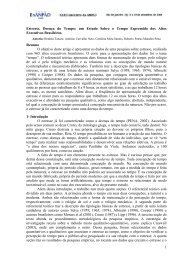Estimating Total Claim Size in the Auto Insurance Industry: a - Spell
Estimating Total Claim Size in the Auto Insurance Industry: a - Spell
Estimating Total Claim Size in the Auto Insurance Industry: a - Spell
You also want an ePaper? Increase the reach of your titles
YUMPU automatically turns print PDFs into web optimized ePapers that Google loves.
Available onl<strong>in</strong>e at<br />
http://www.anpad.org.br/bar<br />
BAR, Curitiba, v. 8, n. 1, art. 3,<br />
pp. 37-47, Jan./Mar. 2011<br />
<strong>Estimat<strong>in</strong>g</strong> <strong>Total</strong> <strong>Claim</strong> <strong>Size</strong> <strong>in</strong> <strong>the</strong> <strong>Auto</strong> <strong>Insurance</strong> <strong>Industry</strong>: a<br />
Comparison between Tweedie and Zero-Adjusted Inverse<br />
Gaussian Distribution<br />
* Correspond<strong>in</strong>g author: Adriana Bruscato Bortoluzzo<br />
Rua Quatá, 300, São Paulo, SP, 04546-042, Brazil.<br />
Adriana Bruscato Bortoluzzo *<br />
E-mail address: adrianab@<strong>in</strong>sper.org.br<br />
Ibmec São Paulo<br />
São Paulo, SP, Brazil.<br />
Danny Pimentel Claro<br />
E-mail address: dannypc@<strong>in</strong>sper.org.br<br />
Ibmec São Paulo<br />
São Paulo, SP, Brazil.<br />
Marco Antonio Leonel Caetano<br />
E-mail address: marcoalc1@<strong>in</strong>sper.org.br<br />
Ibmec São Paulo<br />
São Paulo, SP, Brazil.<br />
R<strong>in</strong>aldo Artes<br />
E-mail address: r<strong>in</strong>aldoa@<strong>in</strong>sper.org.br<br />
Ibmec São Paulo<br />
São Paulo, SP, Brazil.<br />
Copyright © 2011 Brazilian Adm<strong>in</strong>istration Review. All rights reserved, <strong>in</strong>clud<strong>in</strong>g rights for<br />
translation. Parts of this work may be quoted without prior knowledge on <strong>the</strong> condition that <strong>the</strong><br />
source is identified.
A. B. Bortoluzzo, D. P. Claro, M. A. L. Caetano, R. Artes<br />
Abstract<br />
The objective of this article is to estimate <strong>in</strong>surance claims from an auto dataset us<strong>in</strong>g <strong>the</strong> Tweedie and zeroadjusted<br />
<strong>in</strong>verse Gaussian (ZAIG) methods. We identify factors that <strong>in</strong>fluence claim size and probability, and<br />
compare <strong>the</strong> results of <strong>the</strong>se methods which both forecast outcomes accurately. Vehicle characteristics like<br />
territory, age, orig<strong>in</strong> and type dist<strong>in</strong>ctly <strong>in</strong>fluence claim size and probability. This dist<strong>in</strong>ct impact is not always<br />
present <strong>in</strong> <strong>the</strong> Tweedie estimated model. <strong>Auto</strong> <strong>in</strong>surers should consider estimat<strong>in</strong>g total claim size us<strong>in</strong>g both <strong>the</strong><br />
Tweedie and ZAIG methods. This allows for an estimation of confidence <strong>in</strong>terval based on empirical quantiles<br />
us<strong>in</strong>g bootstrap simulation. Fur<strong>the</strong>rmore, <strong>the</strong> fitted models may be useful <strong>in</strong> develop<strong>in</strong>g a strategy to obta<strong>in</strong><br />
premium pric<strong>in</strong>g.<br />
Key words: auto <strong>in</strong>surance; claim size; regression; Tweedie; ZAIG mater.<br />
BAR, Curitiba, v. 8, n. 1, art. 3, pp. 37-47, Jan./Mar. 2011 www.anpad.org.br/bar<br />
38
<strong>Estimat<strong>in</strong>g</strong> <strong>Total</strong> <strong>Claim</strong> <strong>Size</strong> <strong>in</strong> <strong>the</strong> <strong>Auto</strong> <strong>Insurance</strong> <strong>Industry</strong><br />
Introduction<br />
There is a well known problem <strong>in</strong> <strong>the</strong> <strong>in</strong>surance <strong>in</strong>dustry concern<strong>in</strong>g <strong>the</strong> proper pric<strong>in</strong>g of an<br />
<strong>in</strong>surance policy. An <strong>in</strong>surance company’s pure premium for an <strong>in</strong>sured <strong>in</strong>dividual is made up of two<br />
components: claim probability and expected claim size. The claim probability for any <strong>in</strong>dividual is<br />
related to <strong>the</strong> number of claims expected to occur <strong>in</strong> a given year. The claim size is simply <strong>the</strong> dollar<br />
cost associated with each claim. The difficulty of estimat<strong>in</strong>g <strong>the</strong> size and probability of claims <strong>in</strong> <strong>the</strong><br />
<strong>in</strong>surance <strong>in</strong>dustry has been extensively reported <strong>in</strong> <strong>the</strong> literature (e.g. Jong & Heller, 2008). In <strong>the</strong><br />
past, <strong>the</strong> ma<strong>in</strong> difficulty was related to <strong>the</strong> credibility of <strong>the</strong> <strong>in</strong>surance company datasets (Weisberg &<br />
Tomberl<strong>in</strong>, 1982). <strong>Insurance</strong> datasets were typically very large, conta<strong>in</strong><strong>in</strong>g from tens of thousands to<br />
millions of cases. Problems such as miss<strong>in</strong>g values and <strong>in</strong>consistent or <strong>in</strong>valid records arose. As<br />
current <strong>in</strong>formation technology systems have become more sophisticated over <strong>the</strong> years, <strong>the</strong><br />
process<strong>in</strong>g of <strong>in</strong>formation has become more credible than ever before.<br />
The challenge <strong>the</strong>n is to employ a proper statistical technique to analyze <strong>in</strong>surance data. <strong>Claim</strong>s<br />
and risks have long been estimated us<strong>in</strong>g a pure algorithmic technique or a simple stochastic technique<br />
(Wüthrich & Merz, 2008). These methods result <strong>in</strong> poor estimations. Huang, Zhao and Tang (2009)<br />
consider a risk model <strong>in</strong> which <strong>the</strong> claim number process is treated as a Poisson model and <strong>the</strong><br />
<strong>in</strong>dividual claim size is assumed to be a fuzzy random variable. Jørgensen and Souza (1994) suggested<br />
a Poisson sum of Gamma random variables called Tweedie to estimate <strong>in</strong>surance risk. Accord<strong>in</strong>g to<br />
Smyth and Jørgensen (2002), <strong>the</strong>re is also ano<strong>the</strong>r problem <strong>in</strong> that <strong>the</strong> proposed Tweedie model does<br />
not permit <strong>the</strong> separate estimation of probability and claim size.<br />
Recent studies have perceived that a zero-adjusted Inverse Gaussian (ZAIG) distribution may be<br />
appropriate to estimate claim and risk <strong>in</strong> <strong>in</strong>surance data (Heller, Stas<strong>in</strong>opoulos, & Rigby, 2006). A<br />
mixed discrete-cont<strong>in</strong>uous model, with a probability mass of zero and an Inverse Gaussian cont<strong>in</strong>uous<br />
component, appears to estimate accurately <strong>in</strong> extreme right skewness distributions. This suggests that<br />
probabilities can be calculated from datasets with a large number of zero claims. The ZAIG model<br />
explicitly specifies a logit-l<strong>in</strong>ear model for <strong>the</strong> occurrence of a claim (i.e. claim probability). When a<br />
claim has been made, <strong>the</strong> ZAIG model also specifies log-l<strong>in</strong>ear models for <strong>the</strong> mean claim size and <strong>the</strong><br />
dispersion of claim sizes. It is important to measure <strong>the</strong> probability and size of claims separately<br />
because it is possible for <strong>the</strong> probability to depend on a set of <strong>in</strong>dependent variables which is different<br />
from those that <strong>in</strong>fluence claim size. Therefore, ZAIG estimation appears to be more appropriate for<br />
estimat<strong>in</strong>g <strong>the</strong> price of <strong>in</strong>surance policies.<br />
Once an estimation method has been def<strong>in</strong>ed, <strong>the</strong> challenge is to identify potential explanatory<br />
variables. Typically, policy holders are divided <strong>in</strong>to discrete classes on <strong>the</strong> basis of certa<strong>in</strong> measurable<br />
characteristics predictive of <strong>the</strong>ir propensity to generate losses. We evaluate claims by consider<strong>in</strong>g<br />
vehicle variables that are frequently used <strong>in</strong> <strong>the</strong> literature. In addition to territory, claims have also<br />
been studied <strong>in</strong> relation to <strong>the</strong> car manufacturer and vehicle’s characteristics: age, type and orig<strong>in</strong>.<br />
Based on previous research, all of <strong>the</strong>se variables must be used <strong>in</strong> <strong>the</strong> estimation.<br />
Our objective is to present <strong>the</strong> ZAIG method of estimation to determ<strong>in</strong>e probability claims and<br />
<strong>the</strong> expected claim size <strong>in</strong> <strong>the</strong> <strong>in</strong>surance <strong>in</strong>dustry and to formally test <strong>the</strong> results with an estimation<br />
based on a Tweedie regression model us<strong>in</strong>g an <strong>in</strong>surance dataset. <strong>Insurance</strong> data were collected to<br />
analyze <strong>the</strong> impact of factors estimated by <strong>the</strong> Tweedie and ZAIG methods.<br />
This work is divided <strong>in</strong>to five sections. In <strong>the</strong> next section, we will discuss <strong>the</strong> <strong>the</strong>oretical<br />
background based on previous research <strong>in</strong> <strong>in</strong>surance claim estimates. We also present <strong>the</strong> Tweedie and<br />
ZAIG methods <strong>in</strong> <strong>the</strong> next section. The third section discusses <strong>the</strong> methodology and <strong>the</strong> dataset. The<br />
fourth section presents <strong>the</strong> analysis of <strong>the</strong> results and a comparison of <strong>the</strong> f<strong>in</strong>d<strong>in</strong>gs from <strong>the</strong> two<br />
methods. F<strong>in</strong>ally, we present our conclud<strong>in</strong>g remarks and highlight <strong>the</strong> major contributions of our<br />
study.<br />
BAR, Curitiba, v. 8, n. 1, art. 3, pp. 37-47, Jan./Mar. 2011 www.anpad.org.br/bar<br />
39
A. B. Bortoluzzo, D. P. Claro, M. A. L. Caetano, R. Artes<br />
Theoretical Background<br />
<strong>Insurance</strong>: importance of predictions and predictors<br />
The probability and claim size forecast is very important, s<strong>in</strong>ce an <strong>in</strong>surance company can use<br />
<strong>the</strong>se estimates to offer or not offer premium discounts depend<strong>in</strong>g on an <strong>in</strong>dividual client’s<br />
characteristics or create strategies for detect<strong>in</strong>g fraudulent claims (Viaene, Ayuso, Guillen, Van Gheel,<br />
& Dedene, 2007). An <strong>in</strong>surance company can also estimate total claim size us<strong>in</strong>g vehicles<br />
characteristics to get an idea of how much will be spent on <strong>the</strong> claim over a certa<strong>in</strong> period and for a<br />
specific client portfolio. <strong>Insurance</strong> companies are constantly look<strong>in</strong>g for ways to better predict claims.<br />
Overall, <strong>in</strong>surance <strong>in</strong>volves <strong>the</strong> sum of a large number of <strong>in</strong>dividual risks of which very few will result<br />
<strong>in</strong> <strong>in</strong>surance claims be<strong>in</strong>g made. Meulbroek (2001) argues that <strong>in</strong>surance companies need to treat risk<br />
management as a series of related factors and events. Boland (2007) suggests that, <strong>in</strong> order to handle<br />
claims aris<strong>in</strong>g from <strong>in</strong>cidents that have already occurred, <strong>in</strong>surers must employ predictive methods to<br />
deal with <strong>the</strong> extent of this liability. Therefore, an <strong>in</strong>surance company has to f<strong>in</strong>d ways to predict<br />
claims and appropriately charge a premium to cover this risk.<br />
The prediction problem has to be considered <strong>in</strong> <strong>the</strong> light of competitive market <strong>in</strong>surance<br />
(Weisberg, Tomberl<strong>in</strong>, & Chartterjee, 1984). It is possible for an <strong>in</strong>surer to benefit at least temporarily<br />
by identify<strong>in</strong>g segments of <strong>the</strong> market that are currently be<strong>in</strong>g overcharged and offer<strong>in</strong>g coverage at<br />
lower rates or by avoid<strong>in</strong>g segments that are be<strong>in</strong>g undercharged (Doherty, 1981). Regulators are<br />
usually concerned about <strong>the</strong> possibility of rate structures that severely penalize <strong>in</strong>dividuals with some<br />
characteristics (e.g. where <strong>the</strong>y live, model of vehicle). Therefore, <strong>in</strong>surers look for better ways to<br />
capture <strong>the</strong> characteristics of <strong>in</strong>dividuals that affect claim size and probability, and consequently<br />
identify <strong>in</strong>sured drivers that have a higher propensity for generat<strong>in</strong>g losses.<br />
<strong>Insurance</strong> companies attempt to estimate reasonable prices for <strong>in</strong>surance policies based on <strong>the</strong><br />
losses reported for certa<strong>in</strong> k<strong>in</strong>ds of policy holders. This estimate has to consider past data <strong>in</strong> order to<br />
grasp <strong>the</strong> trends that have occurred (Weisberg & Tomberl<strong>in</strong>, 1982). Information available to predict<br />
<strong>the</strong> price for a period <strong>in</strong> <strong>the</strong> future usually consists of <strong>the</strong> claim experience for a population or a large<br />
sample from <strong>the</strong> population over a period <strong>in</strong> <strong>the</strong> past. Accurate estimation may consider a large<br />
number of exposures <strong>in</strong> a dataset and a stable claim generation process over time.<br />
The predictors for estimat<strong>in</strong>g <strong>the</strong> appropriate price for <strong>in</strong>surance policies were selected from <strong>the</strong><br />
automobile <strong>in</strong>dustry. In our study, we consider <strong>the</strong> issue of price prediction <strong>in</strong> <strong>the</strong> context of <strong>the</strong><br />
automobile <strong>in</strong>dustry because <strong>the</strong> most sophisticated proposals have been developed <strong>in</strong> this <strong>in</strong>dustry<br />
(Jong & Heller, 2008). Previous research <strong>in</strong> <strong>the</strong> automobile sett<strong>in</strong>g has used predictors such as territory<br />
(e.g. Chang & Fairley, 1979) and car manufacturer (e.g. Heller et al., 2006). Weisberg et al. (1984)<br />
suggest <strong>in</strong>clud<strong>in</strong>g variables associated with <strong>the</strong> status of <strong>the</strong> vehicle such as age, type and orig<strong>in</strong>.<br />
Previous studies have recognized <strong>the</strong> utility of <strong>the</strong> Tweedie method <strong>in</strong> estimat<strong>in</strong>g auto <strong>in</strong>surance<br />
claims (Smyth & Jørgensen, 2002) and recent studies have shown that <strong>the</strong> ZAIG method may produce<br />
accurate models of estimation (Heller et al., 2006). In order to estimate, it is necessary to let yi be <strong>the</strong><br />
size expended on claims for client i and to let xi be a vector of <strong>in</strong>dependent variables related to this<br />
client. One may represent <strong>the</strong> variable yi as<br />
y<br />
i<br />
⎧ 0, with probability<br />
(1-<br />
π<br />
= ⎨<br />
⎩Wi<br />
, with probability<br />
πi<br />
i<br />
)<br />
where Wi is a positive right skewed distribution. This type of variable belongs to <strong>the</strong> class of <strong>the</strong> zero<br />
<strong>in</strong>flated probability distributions (e.g. Gan, 2000). The parameter πi is <strong>the</strong> claim probability and Wi<br />
represents <strong>the</strong> claim size related to client i.<br />
BAR, Curitiba, v. 8, n. 1, art. 3, pp. 37-47, Jan./Mar. 2011 www.anpad.org.br/bar<br />
40
<strong>Estimat<strong>in</strong>g</strong> <strong>Total</strong> <strong>Claim</strong> <strong>Size</strong> <strong>in</strong> <strong>the</strong> <strong>Auto</strong> <strong>Insurance</strong> <strong>Industry</strong><br />
It is important to note that a claim is, <strong>in</strong> general, a rare event. A small proportion of claims <strong>in</strong> a<br />
sample may lead to problems <strong>in</strong> predict<strong>in</strong>g claim occurrence by a logistic model because, <strong>in</strong> this case,<br />
<strong>the</strong> predicted probabilities tend to be small. K<strong>in</strong>g and Zeng (2001) proposed a correction to be used <strong>in</strong><br />
<strong>the</strong>se situations. They used <strong>the</strong> fact that, <strong>in</strong> <strong>the</strong> presence of rare events, <strong>the</strong> <strong>in</strong>dependent variable<br />
coefficients are consistent, but <strong>the</strong> <strong>in</strong>tercept may not be.<br />
Tweedie regression models<br />
A Tweedie distribution (Jørgensen, 1987, 1997) is a member of <strong>the</strong> class of exponential<br />
dispersion models. It is def<strong>in</strong>ed as a distribution of <strong>the</strong> exponential family (e.g. Jong & Heller, 2008)<br />
with mean μ and variance φ μ p ; <strong>in</strong> this work, as <strong>in</strong> Jørgensen and Souza (1994) and Smyth and<br />
Jørgensen (2002), we consider <strong>the</strong> case 1
A. B. Bortoluzzo, D. P. Claro, M. A. L. Caetano, R. Artes<br />
The follow<strong>in</strong>g models are adjusted:<br />
T<br />
xi<br />
β<br />
e<br />
T<br />
T<br />
xi<br />
γ<br />
xi<br />
δ<br />
πi<br />
= T , μ<br />
xi<br />
β i = e and λ i = e .<br />
1+<br />
e<br />
In short, this model<strong>in</strong>g option assures that μi and λi are, as expected, always positive and that πi<br />
is modeled as a logistic regression. It is important to remember <strong>the</strong> bad performance of logistic models<br />
<strong>in</strong> predict<strong>in</strong>g claims, when <strong>the</strong> frequency of claims <strong>in</strong> <strong>the</strong> sample is small.<br />
Results and Discussion<br />
Dataset and sample summary statistics<br />
A sample was collected from a major automobile <strong>in</strong>surance company result<strong>in</strong>g <strong>in</strong> a dataset of<br />
32,783 passenger vehicle records belong<strong>in</strong>g to a corporate fleet. As all corporation employees could<br />
drive <strong>the</strong> vehicle, it makes no sense to use <strong>in</strong>dividual driver characteristics as explanatory variables for<br />
expla<strong>in</strong><strong>in</strong>g probability and claim size.<br />
The dataset was processed to remove miss<strong>in</strong>g values and generate a selection of relevant<br />
variables. We have focused <strong>the</strong> analysis on yearly claims <strong>in</strong>volv<strong>in</strong>g robbery or accidents with claim<br />
sizes which were greater than <strong>the</strong> vehicle’s value. <strong>Claim</strong> size refers to <strong>the</strong> dollar cost paid as a liability<br />
of a claim. <strong>Claim</strong> probability refers to <strong>the</strong> percentage of claims over <strong>the</strong> period of a year. The average<br />
annual claim probability is 1.17%, and <strong>the</strong> average claim size is $243.98. When <strong>the</strong> event occurs, <strong>the</strong><br />
average claim size <strong>in</strong>creases to $21,048.03.<br />
For every <strong>in</strong>surance policy holder, twenty explanatory variables were employed. The variables<br />
correspond to vehicle characteristics and are coded by means of b<strong>in</strong>ary variables, as described <strong>in</strong> Table<br />
1. Table 2 shows <strong>the</strong> descriptive statistics of <strong>the</strong> variables.<br />
Table 1<br />
List of Explanatory Variables<br />
Variable Description<br />
Vehicle Age (II) Equals 1 if <strong>the</strong> <strong>in</strong>sured vehicle is one or two years old (<strong>in</strong> relation to contract year),<br />
o<strong>the</strong>rwise 0<br />
Vehicle Age (III) Equals 1 if <strong>the</strong> <strong>in</strong>sured vehicle is three or four years old (<strong>in</strong> relation to contract year),<br />
o<strong>the</strong>rwise 0<br />
Vehicle Age (IV) Equals 1 if <strong>the</strong> <strong>in</strong>sured vehicle is five or six years old (<strong>in</strong> relation to contract year),<br />
o<strong>the</strong>rwise 0<br />
Vehicle Age (V) Equals 1 if <strong>the</strong> <strong>in</strong>sured vehicle is seven to n<strong>in</strong>e years old (<strong>in</strong> relation to contract year),<br />
o<strong>the</strong>rwise 0<br />
Vehicle Age (VI) Equals 1 if <strong>the</strong> <strong>in</strong>sured vehicle is ten or more years old (<strong>in</strong> relation to contract year),<br />
o<strong>the</strong>rwise 0<br />
Orig<strong>in</strong> Equals 1 if <strong>the</strong> <strong>in</strong>sured vehicle is imported and 0 if it is domestic<br />
Model/Manufac. A comb<strong>in</strong>ation of different models and manufacturers <strong>in</strong> <strong>the</strong> dataset. Groups were<br />
assigned on <strong>the</strong> basis of a CHAID analysis.<br />
Territory Clusters of territory were assigned based on Hierarchical Cluster Analysis Method for<br />
claim size. It divides <strong>the</strong> region <strong>in</strong>to a set of exclusive areas thought to be relatively<br />
homogeneous <strong>in</strong> terms of claims. Vehicles are assigned to territories accord<strong>in</strong>g to where<br />
<strong>the</strong>y were usually garaged.<br />
BAR, Curitiba, v. 8, n. 1, art. 3, pp. 37-47, Jan./Mar. 2011 www.anpad.org.br/bar<br />
42<br />
(2)<br />
Cont<strong>in</strong>ues
<strong>Estimat<strong>in</strong>g</strong> <strong>Total</strong> <strong>Claim</strong> <strong>Size</strong> <strong>in</strong> <strong>the</strong> <strong>Auto</strong> <strong>Insurance</strong> <strong>Industry</strong><br />
Table 1 (cont<strong>in</strong>ued)<br />
Variable Description<br />
Vehicle Type (II) Equals 1 for a midsize vehicle, o<strong>the</strong>rwise 0<br />
Vehicle Type (III) Equals 1 for a luxury vehicle, o<strong>the</strong>rwise 0<br />
Intercept New Vehicle (zero years old <strong>in</strong> relation to contract year - Vehicle’s Age (I)), Domestic,<br />
Model/Manufacturer (I), Territory (I) and small vehicle (Vehicle Type (I))<br />
Table 2<br />
Descriptive Statistics for Proportion of <strong>Claim</strong>s and for <strong>Claim</strong> <strong>Size</strong><br />
Vehicle Age<br />
Variable Value<br />
Percentage of<br />
<strong>Claim</strong><br />
<strong>Claim</strong> size<br />
<strong>Total</strong> Sample <strong>Claim</strong> <strong>Size</strong>>0<br />
Mean SD Mean SD<br />
Sample<br />
<strong>Size</strong><br />
I 0.94 307.44 3,522.98 32,795.57 16,171.44 8,854<br />
II 1.08 246.91 2,719.76 23,072.27 12,883.00 10,559<br />
III 1.12 208.37 2,173.75 18,807.96 8,813.48 6,589<br />
IV 1.10 160.62 1,691.55 14,660.81 7,063.96 3,286<br />
V 2.12 226.53 1,642.89 10,672.59 3,990.81 2,497<br />
VI 2.20 203.04 1,494.61 9,210.65 4,374.82 998<br />
Orig<strong>in</strong> Domestic 1.20 252.60 2,748.35 21,098.32 13,842.19 30,320<br />
Imported 1.11 137.86 1,857.72 19,974.17 10,491.21 2,463<br />
Model/Manuf.<br />
I 1.69 332.55 2,899.69 19,749.50 10,790.52 11,462<br />
II 1.27 628.48 6,015.09 49,380.62 21,589.70 1,100<br />
III 0.38 73.89 1,319.75 19,644.96 9,559.60 1,861<br />
IV 1.11 155.25 1,659.29 14,244.86 7,255.25 6,331<br />
V 2.48 374.20 2,997.42 15,092.71 12,335.49 484<br />
VI 0.82 263.54 3,630.81 32,256.95 26,900.88 612<br />
VII 0.53 92.36 1,361.69 17,497.01 7,007.88 3,789<br />
VIII 0.73 148.82 2,189.99 20,401.90 16,009.04 2,879<br />
IX 1.37 430.87 4,094.29 31,547.34 16,003.95 1,684<br />
X 0.62 204.76 2,697.10 33,030.77 9,728.11 2,581<br />
Territory<br />
I 2.07 502.80 4,213.33 24,259.88 16,871.42 2,895<br />
II 1.08 218.91 2,494.36 20,445.81 12,964.14 29,888<br />
Vehicle Type Small 1.22 184.61 1,860.49 15,351.51 7,435.96 15,218<br />
Midsize 1.45 371.67 3,554.41 25,586.44 15,029.12 11,290<br />
Luxury 0.53 158.21 2,586.10 30,083.29 19,567.01 6,275<br />
Complete Sample 1.17 243.98 2,691.84 21,048.03 13,700.82 32,783<br />
Based on Table 2 one can perceive that claims occur more often with older cars, but <strong>the</strong> cost of<br />
<strong>the</strong> claim reduces as <strong>the</strong> car’s age <strong>in</strong>creases. Domestic and imported vehicles have approximately <strong>the</strong><br />
same percentage of claims and claim sizes. There are differences <strong>in</strong> <strong>the</strong> frequency and cost of claims<br />
BAR, Curitiba, v. 8, n. 1, art. 3, pp. 37-47, Jan./Mar. 2011 www.anpad.org.br/bar<br />
43
A. B. Bortoluzzo, D. P. Claro, M. A. L. Caetano, R. Artes<br />
depend<strong>in</strong>g on <strong>the</strong> model and <strong>the</strong> manufacturer (Model/Manuf). Region I has <strong>the</strong> largest percentage of<br />
claims as well as <strong>the</strong> highest cost for <strong>the</strong>se claims. In terms of vehicle size, most of <strong>the</strong> claims are for<br />
small and midsize cars, while <strong>the</strong> costs <strong>in</strong>crease <strong>in</strong> percentage accord<strong>in</strong>g to <strong>the</strong> size of <strong>the</strong> vehicle.<br />
Inferential analysis<br />
The ZAIG model was estimated by <strong>the</strong> GAMLSS package (Stas<strong>in</strong>opoulos & Rigby, 2007;<br />
Stas<strong>in</strong>opoulos, Rigby, & Akantziliotou, 2008) for <strong>the</strong> R system (R Development Core Team, 2007).<br />
The Tweedie model was estimated us<strong>in</strong>g <strong>the</strong> SPSS package (version 16.0). In this section we divide<br />
<strong>the</strong> sample <strong>in</strong>to two parts: a subsample of 22,783 to fit <strong>the</strong> models, and a subsample of 10,000 to<br />
forecast <strong>the</strong> total claim size.<br />
Table 3 shows <strong>the</strong> results of <strong>the</strong> estimates. The dependent variable is <strong>the</strong> claim size and refers to<br />
robberies or accidents with repair sizes greater than <strong>the</strong> vehicle’s value.<br />
Table 3<br />
Tweedie and ZAIG Model Results<br />
Variable<br />
Tweedie<br />
Equation 1<br />
Equation 2: ν=1-π<br />
(<strong>Claim</strong> Probability)<br />
ZAIG<br />
Equation 3: μ<br />
(<strong>Claim</strong> <strong>Size</strong>)<br />
Equation 4: λ<br />
Estimate (SE) Estimate (SE) Estimate (SE) Estimate (SE)<br />
Intercept 6.54** (0.29) 3.70** (0.20) 10.20** (0.12) -5.32** (0.11)<br />
Vehicle’s Age (II) -0.18 (0.22) -0.11 (0.18) -0.33** (0.11) -0.24* (0.12)<br />
Vehicle’s Age (III) -0.48* (0.27) 0.01 (0.20) -0.57 1.71) 3.22** (0.14)<br />
Vehicle’s Age (IV) -0.56* (0.34) -0.21 (0.23) -0.94** (0.12) -0.09 (0.16)<br />
Vehicle’s Age (V) -0.10 (0.35) -0.86** (0.21) -1.02** (0.11) -0.52** (0.14)<br />
Vehicle’s Age (VI) -0.12 (0.52) -0.86** (0.30) -1.28** (0.12) -0.38** (0.21)<br />
Model/Manuf (II) 1.01** (0.40) -0.20 (0.31) 0.66** (0.12)<br />
Model/Manuf (III) -0.89* (0.49) 0.79* (0.43) 0.29** (0.11)<br />
Model/Manuf (IV) -0.74** (0.26) 0.49** (0.17) -0.05 (0.08)<br />
Model/Manuf (V) 0.28 (0.68) -0.89** (0.36) 0.22** (0.1)<br />
Model/Manuf (VI) 0.04 (0.65) 0.33 (0.52) 0.21 (0.50)<br />
Model/Manuf (VII) -1.24** (0.35) 1.27** (0.28) 0.20 (0.14)<br />
Model/Manuf (VIII) -0.69* (0.35) 0.98** (0.30) 0.74** (0.12)<br />
Model/Manuf (IX) 0.24 (0.37) 0.23 (0.30) 0.30** (0.11)<br />
Model/Manuf (X) -0.57 (0.37) 0.98** (0.33) 0.36** (0.16)<br />
Orig<strong>in</strong> -0.37 (0.40) 0.09 (0.31) 0.13 (0.09)<br />
Territory (II) -0.84** (0.22) 0.61** (0.15) -0.10* (0.06)<br />
Vehicle Type (II) 0.35 (0.22) -0.12 (0.15) 0.12 (0.08) 0.22** (0.09)<br />
Vehicle Type (III) -0.23 (0.30) 0.87** (0.25) 0.33** (0.07) -1.37** (0.15)<br />
Scale 2472.92 (107.38)<br />
Note. *p
<strong>Estimat<strong>in</strong>g</strong> <strong>Total</strong> <strong>Claim</strong> <strong>Size</strong> <strong>in</strong> <strong>the</strong> <strong>Auto</strong> <strong>Insurance</strong> <strong>Industry</strong><br />
Several explanatory variables were significantly related to dependent variables. Consider<strong>in</strong>g all<br />
vehicle age variables, we can say that <strong>the</strong>re is a significant <strong>in</strong>crease <strong>in</strong> <strong>the</strong> expected claim probability<br />
as <strong>the</strong> vehicle becomes older. On <strong>the</strong> o<strong>the</strong>r hand, <strong>the</strong> expected claim size decreases for older vehicles.<br />
This is <strong>in</strong> l<strong>in</strong>e with <strong>in</strong>tuition and descriptive analysis, because old vehicles are less expensive to<br />
replace and <strong>the</strong>re is also <strong>the</strong> fact that old vehicles are more attractive targets. One might suggest that<br />
old vehicles are more attractive targets because <strong>the</strong>re is a great auto part replacement market that gets<br />
flooded with stolen parts for <strong>the</strong>se old cars. Older cars also tend to be poorly ma<strong>in</strong>ta<strong>in</strong>ed, and this<br />
<strong>in</strong>creases <strong>the</strong> probability of accidents.<br />
The variable model/manufacturer is related to claim probability and size. In general, <strong>the</strong><br />
model/manufacturer is more closely related to claim probability than claim size. It is noteworthy that<br />
<strong>the</strong>re is no way of clearly identify<strong>in</strong>g whe<strong>the</strong>r claim size or probability is caus<strong>in</strong>g <strong>the</strong> significance of<br />
<strong>the</strong> Tweedie coefficients.<br />
The variable for vehicle orig<strong>in</strong> does not <strong>in</strong>fluence <strong>the</strong> claim probability or size. This suggests,<br />
ceteris paribus, that domestic and imported vehicles tend to have <strong>the</strong> same claim size. Territory is<br />
generally related to claim probability and size; <strong>in</strong> this case <strong>the</strong>re are some regions that have more<br />
carjack<strong>in</strong>gs than o<strong>the</strong>rs.<br />
Vehicle type is related to claim size and probability. The claim probability decreases for luxury<br />
vehicles. However luxury cars lead to higher claim sizes compared to small and midsize cars. Look<strong>in</strong>g<br />
at <strong>the</strong> Tweedie results, <strong>the</strong> difficulty <strong>in</strong> accurately predict<strong>in</strong>g claims becomes obvious given <strong>the</strong> nonsignificance<br />
of <strong>the</strong> Tweedie coefficient for vehicle type. One might suggest that <strong>the</strong> non-significant<br />
coefficient is due to a negative claim probability effect and a positive claim size effect, as found <strong>in</strong> <strong>the</strong><br />
ZAIG coefficients.<br />
The total claim size forecast was made by add<strong>in</strong>g toge<strong>the</strong>r <strong>the</strong> <strong>in</strong>dividual forecast claim sizes<br />
based on <strong>the</strong> Tweedie and ZAIG models. Us<strong>in</strong>g parametric bootstrap simulation, we obta<strong>in</strong>ed a 95%<br />
confidence <strong>in</strong>terval, based on empirical quantiles of 5,000 bootstrap estimates. For fur<strong>the</strong>r details, see<br />
Efron and Tibishirani (1986).<br />
Table 4 shows <strong>the</strong> estimated and true total claim size and <strong>the</strong> 95% confidence <strong>in</strong>terval. The<br />
ZAIG model was better than <strong>the</strong> Tweedie model when it came to forecast<strong>in</strong>g <strong>the</strong> total claim size, and<br />
both models showed negative bias. We notice that <strong>the</strong> forecasts lie with<strong>in</strong> <strong>the</strong> confidence bands for<br />
both models, <strong>in</strong>dicat<strong>in</strong>g good estimation results. Us<strong>in</strong>g <strong>in</strong>ferior and superior limits, <strong>the</strong> <strong>in</strong>surance<br />
company can beg<strong>in</strong> to picture total claim size dispersion.<br />
We also calculated <strong>the</strong> mean squared error (MSE) and <strong>the</strong> mean absolute error (MAE) for <strong>the</strong><br />
residuals. The results are very similar for both <strong>the</strong> Tweedie and ZAIG models.<br />
Table 4<br />
<strong>Total</strong> claim size, <strong>in</strong>ferior and superior limits, mean squared error and mean absolute error for<br />
Tweedie and ZAIG models<br />
Tweedie ZAIG True<br />
<strong>Total</strong> <strong>Claim</strong> <strong>Size</strong> $ 2,089,845 $ 2,213,629 $ 2,432,513<br />
LI $ 1,407,114 $ 1,429,470<br />
LS $ 4,407,782 $ 3,230,824<br />
MSE 4.2999x10 12 4.7492x10 12<br />
MAE 2,075,580 2,184,292<br />
BAR, Curitiba, v. 8, n. 1, art. 3, pp. 37-47, Jan./Mar. 2011 www.anpad.org.br/bar<br />
45
A. B. Bortoluzzo, D. P. Claro, M. A. L. Caetano, R. Artes<br />
Conclud<strong>in</strong>g Remarks<br />
In this work we have tackled a well-known problem <strong>in</strong> <strong>the</strong> <strong>in</strong>surance <strong>in</strong>dustry, which is <strong>the</strong><br />
proper pric<strong>in</strong>g of an <strong>in</strong>surance policy. Employ<strong>in</strong>g <strong>the</strong> ZAIG estimation method for claims and risks <strong>in</strong><br />
<strong>the</strong> <strong>in</strong>surance <strong>in</strong>dustry, we found dist<strong>in</strong>ct factors that <strong>in</strong>fluence claim size and probability. Factors such<br />
as territory, a vehicle’s advanced age, orig<strong>in</strong> and type dist<strong>in</strong>ctly <strong>in</strong>fluence claim size and probability.<br />
The dist<strong>in</strong>ct impact is not always present <strong>in</strong> <strong>the</strong> Tweedie estimated model. The ZAIG estimation<br />
method also allows <strong>in</strong>surance companies to create a score system to predict claims, based on <strong>the</strong><br />
logistic model. This score system identifies policy holders who tend to be more risky. These estimated<br />
models thus may be employed to develop a strategy for premium pric<strong>in</strong>g. Moreover, <strong>in</strong>surance<br />
companies can use vehicle characteristics to estimate total claim size and thus get an idea of how<br />
much <strong>the</strong>y will have to spend on a claim over a certa<strong>in</strong> period of time and for a specific client<br />
portfolio.<br />
Some limitations to this study should be po<strong>in</strong>ted out. First, <strong>the</strong> methods require a high<br />
computational effort that may preclude <strong>the</strong> use of larger datasets. Second, <strong>the</strong>re is room for develop<strong>in</strong>g<br />
suitable methods for longitud<strong>in</strong>al data analysis. Future work may consider <strong>the</strong> use of estimat<strong>in</strong>g<br />
equation techniques or multivariate ZAIG distributions. We concentrated our research on <strong>the</strong> auto<br />
<strong>in</strong>surance <strong>in</strong>dustry and specific vehicle variables. Fur<strong>the</strong>r studies may address o<strong>the</strong>r <strong>in</strong>surance<br />
<strong>in</strong>dustries and <strong>in</strong>clude customer related variables.<br />
Received 03 February 2010; received <strong>in</strong> revised form 28 June 2010.<br />
References<br />
Boland, P. J. (2007). Statistical and probabilistic methods <strong>in</strong> actuarial science. Boca Raton: Chapman<br />
& Hall/CRC.<br />
Chang, L., & Fairley, W. B. (1979). Pric<strong>in</strong>g automobile <strong>in</strong>surance under multivariate classification of<br />
risks: additive versus multiplicative. The Journal of Risk and <strong>Insurance</strong>, 46(2), 75-98.<br />
Doherty, N. A. (1981). Is rate classification profitable? The Journal of Risk and <strong>Insurance</strong>, 48(2), 286-<br />
295.<br />
Efron, B., & Tibshirani R. (1986). Bootstrap methods for standard errors, confidence <strong>in</strong>tervals, and<br />
o<strong>the</strong>r measures of statistical accuracy. Statistical Science, 1(1), 54-75. doi:<br />
10.1214/ss/1177013815<br />
Gan, N. (2000). General zero-<strong>in</strong>flated models and <strong>the</strong>ir applications. Unpublished doctoral<br />
dissertation, North Carol<strong>in</strong>a State University, North Carol<strong>in</strong>a, United States of America.<br />
Heller, G., Stas<strong>in</strong>opoulos, M., & Rigby, B. (2006, July). The zero-adjusted <strong>in</strong>verse Gaussian<br />
distribution as a model for <strong>in</strong>surance claims. Proceed<strong>in</strong>gs of <strong>the</strong> International Workshop on<br />
Statistical Modell<strong>in</strong>g, Galway, Ireland, 21.<br />
Huang, T., Zhao, R., & Tang, W. (2009). Risk model with fuzzy random <strong>in</strong>dividual claim amount.<br />
European Journal of Operational Research, 192(3), 879-890. doi:10.1016/j.ejor.2007.10.035<br />
Jong, P., & Heller, G. Z. (2008). Generalized l<strong>in</strong>ear models for <strong>in</strong>surance data. Cambridge:<br />
Cambridge University Press.<br />
Jørgensen, B. (1987). Exponential dispersion models. Journal of <strong>the</strong> Royal Statistical Society, 49(2),<br />
127-162.<br />
BAR, Curitiba, v. 8, n. 1, art. 3, pp. 37-47, Jan./Mar. 2011 www.anpad.org.br/bar<br />
46
<strong>Estimat<strong>in</strong>g</strong> <strong>Total</strong> <strong>Claim</strong> <strong>Size</strong> <strong>in</strong> <strong>the</strong> <strong>Auto</strong> <strong>Insurance</strong> <strong>Industry</strong><br />
Jørgensen, B. (1997). Theory of dispersion models. London: Chapman & Hall.<br />
Jørgensen, B., & Souza, M. C. P. de (1994). Fitt<strong>in</strong>g Tweedie´s compound Poisson model to <strong>in</strong>surance<br />
claims data. Scand<strong>in</strong>avian Actuarial Journal, 1(1), 69-93.<br />
K<strong>in</strong>g, G., & Zeng, L. (2001). Logistic regression <strong>in</strong> rare events data. Political Analysis, 9(2), 137-163.<br />
Meulbroek, L. (2001). A better way to manage risk. Harvard Bus<strong>in</strong>ess Review, 79(2), 22-23.<br />
R Development Core Team (2007). R: A language and environment for statistical comput<strong>in</strong>g. R<br />
foundation for statistical comput<strong>in</strong>g, Vienna, Austria. Retrieved January 12, 2008, from<br />
http://cran.r-project.org/doc/manuals/refman.pdf<br />
Smyth, G. K., & Jørgensen, B. (2002). Fitt<strong>in</strong>g tweedie’s compound poisson model to <strong>in</strong>surance claims<br />
data: dispersion model<strong>in</strong>g. Actuarial Studies <strong>in</strong> Non-life <strong>in</strong>surance (ASTIN) Bullet<strong>in</strong>, 32(1), 143-<br />
157. doi: 10.2143/AST.32.1.1020<br />
Stas<strong>in</strong>opoulos, D. M., & Rigby, R. A. (2007). Generalized additive models for location scale and<br />
shape (GAMLSS). Journal of Statistical Software, 23(7), 1-46.<br />
Stas<strong>in</strong>opoulos, D. M., Rigby R. A., & Akantziliotou, C. (2006). Instructions on how to use <strong>the</strong><br />
GAMLSS package <strong>in</strong> R (Technical Report 01/06), London, UK, STORM Research Centre,<br />
London Metropolitan University.<br />
Viaene, S., Ayuso, M., Guillen, M., Van Gheel, D., & Dedene, G. (2007). Strategies for detect<strong>in</strong>g<br />
fraudulent claims <strong>in</strong> <strong>the</strong> automobile <strong>in</strong>surance <strong>in</strong>dustry. European Journal of Operational<br />
Research, 176(1), 565-583. doi:10.1016/j.ejor.2005.08.005<br />
Weisberg, H. I., & Tomberl<strong>in</strong>, T. J. (1982). A statistical perspective on actuarial methods for<br />
estimat<strong>in</strong>g pure premiums from cross-classified data. The Journal of Risk and <strong>Insurance</strong>, 49(4),<br />
539-563.<br />
Weisberg, H. I., Tomberl<strong>in</strong>, T. J., & Chartterjee, S. (1984). Predict<strong>in</strong>g <strong>in</strong>surance losses under crossclassification:<br />
a comparison of alternative approaches. Journal of Bus<strong>in</strong>ess & Economic<br />
Statistics, 2(2), 170-178.<br />
Wüthrich, M. V., & Merz, M. (2008). Stochastic claims reserv<strong>in</strong>g methods <strong>in</strong> <strong>in</strong>surance. West Sussex:<br />
John Wiley & Sons.<br />
BAR, Curitiba, v. 8, n. 1, art. 3, pp. 37-47, Jan./Mar. 2011 www.anpad.org.br/bar<br />
47



